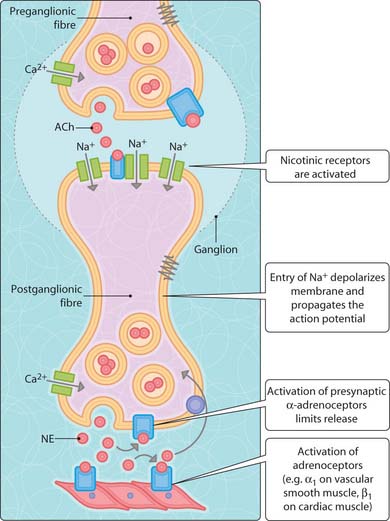7 Sympathetic neurotransmission
The action potential in the postganglionic fibre is generated in the same manner as described in Ch. 6 for the parasympathetic ganglion (Fig. 3.7.1). Here, however, the postganglionic nerve terminal contains enzymes necessary for the synthesis of norepinephrine from l-tyrosine. Norepinephrine is stored in vesicles and released following activation of voltage-dependent calcium channels. The entry of Ca2+ into the nerve terminal triggers the fusion of vesicles with plasma membrane and release of norepinephrine molecules into the neuroeffector junction. The pharmacological action of norepinephrine is short lived, owing to its rapid uptake into sympathetic nerve terminals and either repackaging into storage vesicle or metabolism by the enzyme monoamine oxidase (MAO) to 3-methoxy-4-hydroxymandelic acid. The release of norepinephrine at neuroeffector sites (e.g. vascular smooth muscle) results in activation of adrenoceptors that belong to the family of G-protein-coupled receptors. A variety of drugs can interfere with sympathetic neurotransmission at several sites along this pathway (Fig. 3.7.2). Epinephrine is released from the adrenal glands into the circulation and also acts on α- and β-adrenoceptors on effector cells. It is rapidly metabolized by catechol-O-methyltransferase (COMT) and MAO in the liver and gut wall.
< div class='tao-gold-member'>







